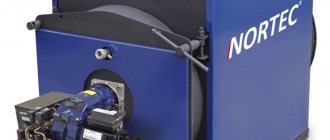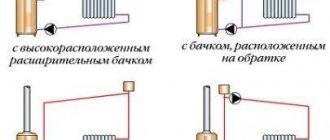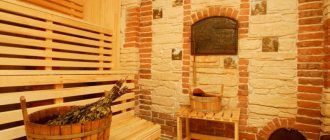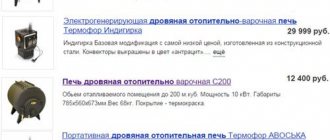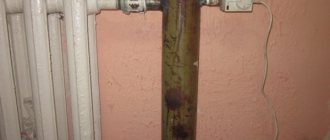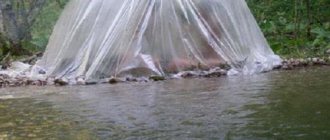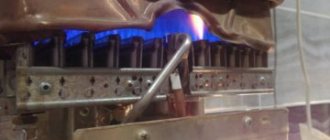Greetings. Today you will learn what a waste boiler is and how to make one from unnecessary scrap metal. In my articles, I have repeatedly posted instructions for assembling economical heating boilers, but this time we will talk about the most inexpensive option.
The cost of homemade waste oil stoves rarely exceeds a thousand rubles, and the price of fuel for such units is still low. Therefore, I am sure that the instructions offered in this article will be useful to many.
How does an exhaust boiler work?
The working principle of a solid fuel boiler is to burn oil - the process is similar to the operation of a blowtorch, that is, the fuel is converted into gas during combustion, and air is drawn in by a nozzle to maintain the flame.
Let us highlight several features of the boiler operation during testing:
- the design provides for two tanks located one above the other;
- to connect the containers there is a pipe through which air moves;
- used oil is poured into the lower container;
- when heated, the oil evaporates and moves into the burner;
- when air enters, the vapors ignite;
- the mixture of burning gases with oxygen moves to the upper container, where it burns completely, and the waste is evacuated into the chimney.
How does a heating device work?
The design of the boiler is extremely simple. It includes two chamber compartments: evaporation and combustion. In the first, the process of preparing the oil for combustion occurs, in the second, it burns.
Everything happens as follows. From the waste reservoir, the pump supplies used oil to the evaporation chamber, which is located at the bottom of the device. Here, a temperature is maintained sufficient for the waste to heat up and begin to evaporate.
This is how a boiler with oil evaporation and forced air supply works (+)
Oil vapor rises to the upper part of the housing, where the combustion chamber is located. It is equipped with an air duct, which is a pipe with holes. Using a fan, air is supplied through the duct and mixed with oil vapor.
The oil-air mixture burns almost without a residue - the resulting heat warms up the heat exchanger, and the combustion products are sent to the chimney.
Preheating the oil is an essential part of the process. You need to understand that the waste contains a large amount of impurities and toxic substances. All this is broken down into simple carbohydrates, which are subsequently burned.
After which water vapor, carbon dioxide and nitrogen are formed - completely harmless elements. However, this result is only possible if certain temperature conditions are met.
Complete oxidation or combustion of hydrocarbons occurs only at a temperature of +600°C. If it is lower or higher by 150-200°C, then during the combustion process a large number of various toxic substances are formed. They are unsafe for humans, so the combustion temperature must be strictly observed.
Detailed manufacturing instructions
Work on the independent production of a boiler operating on waste oil begins with the direct preparation of building materials:
- , a piece about a meter high is cut from a larger diameter pipe
- from a small diameter pipe ;
- One of the steel plates is equipped with a hole, the diameter of which should be 20 cm , and a hole is sawed into the other depending on the diameter of the chimney;
- The cylinder is closed on both sides using these plates and welding. This is done so that at the bottom there is a plate with a hole of a larger diameter;
- Then a small cylinder is welded , the bottom of which is also welded using a plate;
- The legs made of reinforcement are attached to the body and ventilation holes are made.
The result is a cylindrical structure with a small reservoir at the bottom. A door is cut from below, and the system is connected to the chimney from above. To turn on the boiler, open the door, pour waste oil into the tank and set it on fire. This is the most basic design of a furnace, especially since you can often find products that are much more complex.
A standard waste oil boiler usually looks like two boxes made of fairly durable steel. They are located on top of each other and connected using a perforated pipe. A hole is cut in the lower body for filling oil, and the second metal box is connected to the chimney.
It is very easy to make such a design more perfect: connect a supply container with waste oil, a pump for supplying it, a water circuit, a compressor, and so on.

A standard waste oil boiler usually looks like two boxes made of fairly strong steel
A few words about working out
Used oil is waste fuel and lubricants; it is a dark oily liquid that has a strong, specific smell of petroleum products.
The waste contains microparticles of metal, so it is not recommended to use it as a lubricant for an engine or transmission. However, the waste burns as well as ordinary mineral oil, so it is widely used as heating fuel. Incineration of waste can be called one of the methods for recycling fuels and lubricants. Due to the low cost of exhaust, a boiler operating using it is environmentally friendly and economical.
Terms of use
In order for the boiler to serve for a long time without service, it is necessary to pay attention to the rules of use
Fuel
Used oil for boiler operation can be used for almost any purpose. The main thing is that it meets a number of requirements set by device manufacturers.
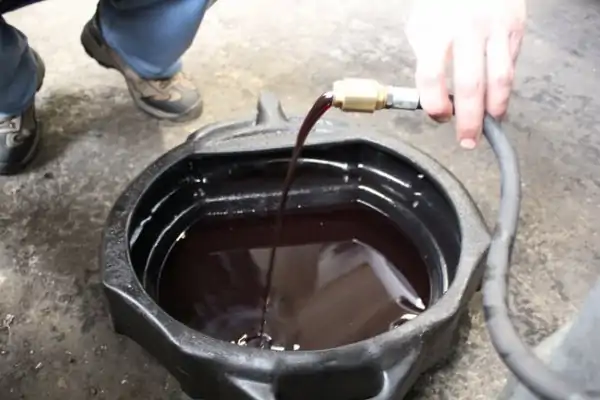
Photo 4. Draining used oil into a special container. The liquid itself is dark brown.
If you have additional filtration systems, feel free to use them. The cleaner the used oil is, the more efficient the combustion process will be. This also affects the fact that you will carry out less preventive maintenance during operation.
If analysis reveals that the fuel contains a large amount of water and antifreeze, then it is necessary to filter the fuel completely. There are special recommendations on how to remove such impurities.
Manufacturers most often recommend using hydraulic, motor, transmission oils, as well as oil from an automatic transmission. But it is not recommended to use fuel oil in the device.
The fuel for the boiler is calculated in accordance with the heat loss for each specific room. It is necessary to take into account data on the insulation of the place, its glazing, the operating mode of the boiler, as well as the required set temperature. Depending on the manufacturer, the calculation will be performed using individual formulas. It is better to contact the manufacturer directly to identify this issue.
The most commonly used formula is:
B = d*(h1-h2) + d*(h1+h2) /qn
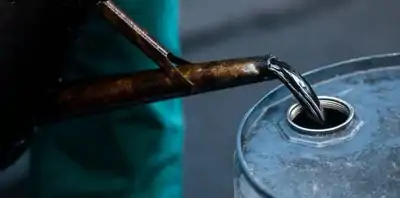
Where: h1 - efficiency factor,
h2 is the enthalpy of the fuel,
d is the heat of combustion of fuel,
qn is the temperature and specific heat of the oil.
How to properly and safely pour fuel into the boiler?
Before starting work, you need to carry out a number of actions that will ensure the safety of using the device:
- Open the container with the liquid. This is necessary so that it has time to interact with oxygen.
- After this, disconnect the device from the network and power, check the degree of sealing of the seams.
- Fill the collection pan with oil. You need to pour a 10mm layer. The oil must be clean.
- Add 100 ml of kerosene to this liquid.
- Take the wick and wet it in the ignition.
- Lower to the bottom of the container.
- Set fire to the waste.
- Watch how the seams and oil behave. All actions must be carried out with gloves.
- Close the lid.
- After this, the device will start working, and you can check how efficiently it functions.
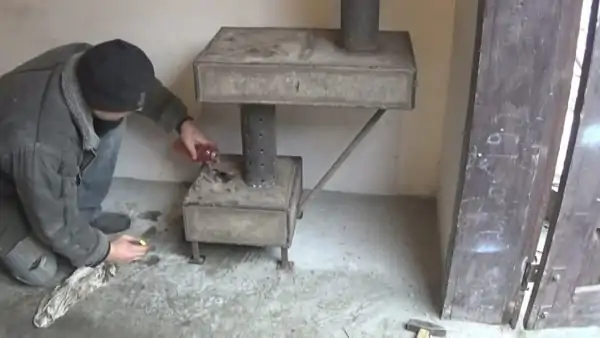
Photo 5. Filling a homemade boiler with waste oil. Fuel is poured into the lower part of the unit.
Do not get oil on foreign parts or parts of the device. During operation, all additional sources of oxygen supply, such as doors or windows, must be closed.
Assembly and commissioning
The bodies of such boilers consist of two pipes inserted into each other, the radius of which should differ from each other by 30–40 mm. The external part must be equipped with 2 outlets - for direct and reverse supply of coolant. And inside the smaller-diameter pipe is a combustion chamber. The waste container is located next to the boiler - a pump is immersed in it to supply fuel to the pyrolysis chamber.

The further installation process includes the following steps:
- Placing another container for oil at the bottom, with the creation of holes in it for gas vapor to enter the chamber for secondary combustion;
- Conducting contacts for electrical ignition of the burner through the combustion door;
- Inserting a fitting, thanks to which a gas-air mixture is formed, into the chamber wall;
- Creation of a chimney with a slide damper to remove combustion products, which the diagram provides;
- Placement of a gas outlet tube lowered to the level of the bowl with oil;
- Installation of a circulation pump on the return line, and safety groups on the direct line.
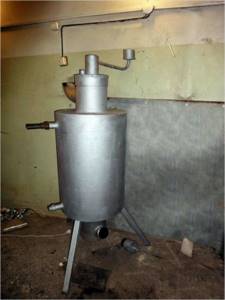
Before starting to operate the equipment, check the degree of sealing of the seams by filling the appropriate containers with oil and water. It is recommended to carry out the first launch by pouring only a 10 mm layer of oil purified from mechanical impurities with the addition of 100 ml of kerosene. The waste is ignited using a wick dipped in lighter fluid and lowered to the bottom of the container.
Balance of advantages and disadvantages
It would seem that the idea is practically devoid of shortcomings, but this is not so. To make an informed decision about using such heating in your home, you need to see not only the advantages of its use, but also the disadvantages.
Let's start with the advantages of the method. So, if you have regular access to waste fuel, which essentially is waste fuel, then you can effectively use and at the same time dispose of this material. Proper use of technology allows you to obtain heat with complete combustion of the material without releasing harmful substances into the atmosphere.
Other advantages include:
- simple design of the heating unit;
- low costs for fuel and equipment;
- the possibility of using any oil that is available on the farm: vegetable, organic, synthetic;
- flammable material can be used even if contaminants make up a tenth of its volume;
- high efficiency.
The disadvantages of the method should be taken seriously. If the process technology is not followed, incomplete combustion of the fuel may occur. Its fumes are dangerous to others.
If there were more disadvantages to heating during development than advantages, such factory-produced products would not appear on sale, which are sold like hot cakes, despite the fairly high prices
It is not for nothing that the main requirement when arranging heating during testing is the presence of ventilation in the room where the boiler will be operated.
We list other disadvantages:
- since good draft requires a high-quality chimney, it must be straight and its length must be at least five meters;
- the chimney and plasma bowl must be cleaned regularly and thoroughly;
- the difficulty of drip technology lies in the problematic ignition: at the time of fuel supply, the bowl should already be red-hot;
- operation of the boiler causes air drying and oxygen burnout;
- independent creation and use of hot water structures can help lower the temperature in the combustion zone, which jeopardizes the efficiency of the process as a whole.
To solve the last of the above problems, you can install a water jacket where it cannot affect the quality of combustion - on the chimney. The listed shortcomings have led to the fact that the product, without significant modifications, is practically not used for heating residential premises.
If you don’t have the desire or time to build a unit with your own hands, you can take advantage of numerous offers from workshops engaged in the production and installation of metal structures of various sizes:
Installation Tips
Installing a boiler that uses waste oil is practically no different from installing other types of heaters. There is one advantage: thanks to the presence of turbocharging and smokeless combustion of liquid fuel, the chimney does not have to be raised by 6-7 meters. It is enough to remove the chimney head from the wind pressure zone and raise it to a height of 4 m.
Regarding proper installation, we will give the following recommendations:
- The boiler and steel chimneys not protected by insulation are located at a distance of 0.5 m from combustible walls and other elements of a wooden house. The minimum distance from fireproof structures is 100 mm.
- Pass through the outer wall and the entire outer section of the flue with an insulated pipe - a sandwich, otherwise there will be a lot of condensation and soot. The chimney installation technology is described in detail in a separate material.
- Be sure to install a safety group on the heating supply line.
- Organize a good exhaust hood in the furnace to remove odors. Combustion air intake can be provided from the street.
- Equip the supercharger with a speed regulator and the oil line with a valve. This will allow you to control the power of the heat generator manually. Do not confuse the control valve with a regular tap; shut-off valves are installed on pipelines in any case.
- Make a primitive automatic emergency stop - install a thermostat on the supply, turn off the fan and the oil pump in case of overheating of the coolant.
Equipment operating rules
The assembled water boiler must be used in compliance with certain rules, the main one of which is the use of a chimney with a suitable cross-sectional diameter. The smoke exhaust system must be equipped with a damper to regulate draft, and the section of its passage through the ceiling and roof is insulated using a heat-resistant casing. And when using the boiler, it is not allowed to add fuel to the heated chamber, cool the boiler with water and turn off the forced-air fan. Compliance with these rules will ensure efficient operation of the equipment and increase the service life of the heating system.
Waste oil furnace manufacturing technology
Below are drawings of the most common waste furnace. It is made from the remains of a pipe Ø352 mm, sheet steel 4 mm and 6 mm, you will also need cuttings of a thick-walled pipe Ø100 mm and a corner for the legs.
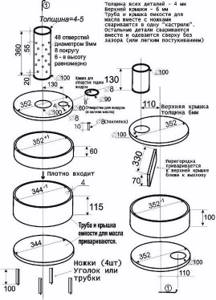
Its dimensions will allow you to heat a room with a standard ceiling height of up to 80 m2; for a larger area, you should increase the size of the stove and the diameter of the chimney pipe.
Required tool:
- welding machine;
- grinder with cutting wheel;
- grinding wheel for cleaning seams;
- drill or drilling machine, drill bits;
- roulette.
You also need a solvent and silicone heat-resistant paint - it is usually sold in cans and is used for painting highly heated surfaces of ovens.
Do-it-yourself manufacturing sequence:
- Prepare blanks according to drawings. All parts are cut out from the material indicated in the drawing and the cut points are cleaned to remove burrs.
- The parts of the lower tank are connected by welding: a body made of a pipe Ø344 mm h=115 mm, a bottom made of sheet metal 4 mm, as well as legs from a corner of any size. Instead of a corner, you can use scraps of an inch pipe.
- In a section of pipe Ø100 mm h=360 mm, using a drill, perforation is performed according to the sketch - 48 holes with a diameter of 9 mm.
- The parts of the lower tank cover are connected by welding: a blank made of pipe Ø352 mm h=60 mm, a cover made of sheet steel 4 mm with two holes and a perforated pipe.
- The damper for the air supply hole on the lid of the lower tank is secured with a rivet.
- The parts of the upper chamber are connected by welding: a blank made of a pipe Ø352 mm h=100 mm and a bottom made of sheet steel 4 mm with a hole for a perforated pipe.
- A chimney Ø100 mm h=130 mm is welded to the cover of the upper chamber, and a partition made of 4 mm sheet steel with dimensions 70x330 mm is welded on the inside of the cover. The partition is designed to cut off the flame and increase the heating efficiency of the upper chamber. It should be located closer to the smoke hole.
- Weld the upper chamber and the lid with the chimney.
- Weld the upper chamber to the top of the perforated pipe; to increase the rigidity of the structure, you can make rod ties between the lid of the lower tank and the upper chamber.
- The upper part of the furnace is pressed onto the lower tank.
- To extend the service life, the furnace is coated with silicone paint, having previously cleaned the welds from scale and the metal from rust using a solvent.
- Connect the stove to the chimney. Its height should be at least 4 meters to improve traction. Since the chimney will have to be frequently cleaned of soot, you need to make it as straight as possible, without bends.
A similar oven can be made from sheet metal, in which case its chambers will be square. Detailed technology is shown in the video.
Making a furnace for mining: video
How to connect a water circuit to the exhaust furnace
The water circuit is connected to a boiler installed on the upper chamber. It can be welded directly onto the surface of the stove, but it is safer to make a separate tank: if the bottom of the tank burns, water will enter the combustion chamber, which can cause burning oil to splash out and cause a sudden ignition.
The tank can be of any shape and height, the main condition is a tight fit to the upper chamber and chimney for more efficient heating. Two fittings are cut into the walls of the tank: in the upper part for heated water, in the lower part for cooled return water.
A thermometer and pressure gauge are installed at the outlet of the tank. A circulation pump and an expansion tank are installed on the return pipe in close proximity to the boiler.
How to weld a simple stove
Then the heat is released in greater quantities into the room, rather than being “thrown out” to the street.
Another upgrade is to make an iron drawer. Oil is poured into it. With this design, the stove is easier to maintain. The drawing contains all the necessary dimensions. Before assembling a homemade oil stove, it is necessary to select the correct diameter of the firebox and body. Here everything depends on the volume of the room that needs to be heated. If it is a garage of 3 by 6 meters, take a profile of 80x80x4 mm. The fuel box is made of metal 60x60x4. It is more difficult to work with round rolled metal.
The step-by-step instructions look like this:
- Cut the metal according to the drawings to make a casing, drawer, afterburner. If the latter has a bend, the tube is cut at an angle of 45 degrees.
- For a profile of a smaller standard size, one wall is cut out with a grinder. Plugs are welded to the sides. The result is an open container to which you need to attach a handle.
- The structure is welded. It is necessary to drill an air hole at the top of the fuel chamber. The pipe is perforated. At this point the work is completed.
It should be taken into account that you need to calculate the number and diameter of holes in the afterburner. If you use a profile of 80 by 80 mm, then the cross-sectional area will be equal to 6400 square millimeters. This value is divided in two
Pay attention to the markings of the drill used. If it is 8 mm, then the hole area will be 50 sq. mm
Now 3200 must be divided by 50. The result is that 64 holes will be required to work effectively. However, as a result of customization, their number can be increased.
It is important that the chimney is of sufficient length. The elevation of the chimney outlet must be at least 5 meters
Then the operation of the stove during testing will ensure the highest possible efficiency even without supercharging. Otherwise, the pipe will have to be extended to this mark. But you can further increase productivity if you organize an inclined chimney running along the wall. The heated metal will release heat into the room. Only in this case is it important to follow fire safety rules. There should be no wooden shelves above the pipe, and no wallpaper on the walls. Even better is to cover the wall with a metal sheet.
Making a drip heater
Professionals who have assembled more than one “dripper” use old propane cylinders with a diameter of 200 mm. Oxygen ones are also suitable, since their cross section is 220 mm. the latter benefit due to thick walls. They serve for a long time, do not burn out, and accumulate heat. Pipe C-10 is also suitable if it has a wall thickness of 5 mm. An excellent option for a durable housing is pipes made of heat-resistant stainless steel alloys, alloyed chromium, molybdenum or nickel (for example, 15X1MF or 12X18H12T) with a wall no more than 3 mm. However, it is not advisable to specifically purchase this raw material due to its high cost.
Technologically, the manufacturing process is as follows:
- A flame bowl is made using a piece of pipe or ready-made steel containers. This one is pulled out through a rubber hatch, so it is not made too big.
- The openings necessary for connecting the chimney pipe and the cleaning service hatch are cut out in the body. The latter is framed and closed with a door. Bolts can be used for fastening.
- An afterburner is being made. All holes are not made at once. Usually the bottom 2-3 rows are drilled, and the rest are drilled during the setup process. If you do everything at once and there are too many of them, you will have to make a new one.
- Weld the cover with the air duct and flange. The latter is necessary for installing the fan. The fuel supply device is connected. Photo and video instructions will help here.
Now assemble all the components and connect the electrical wiring. The structure will be more stable if you make a metal frame. A heavy metal profile is suitable for this.
How Gecko boilers function
To become familiar with the general principle of operation, it is necessary to familiarize yourself with the stages of converting fuel into thermal energy.
- Through the fuel line (9) the used oil enters the evaporator (11).
- Under the influence of temperature, the above-described transformation into gas occurs.
- Since it is lighter than air, the vapors rise through the vortex device (14).
- Passing through the holes in this element, they ignite in the afterburner.
- An air blower enriches the mixture with oxygen, which increases thermal output.
- Energy is transferred to the coolant (water, antifreeze) through the walls of the heat exchanger. They are in the afterburner.
To remove carbon monoxide, a flue is provided in the design. It is also designed to create draft that ensures the circulation of air flows inside the combustion chamber.
Making such a design with your own hands is not problematic. The main thing is to choose the right manufacturing material and act according to the developed technological scheme, taking into account the specifics of the drawing.
Waste oil heating for a private home
Waste heating oil was initially used together with diesel fuel. This method has proven its effectiveness and cost-effectiveness. Then they decided to reduce the cost of the product even more and removed diesel fuel from the composition. Used oil resembles diesel fuel in its characteristics, but is much cheaper.
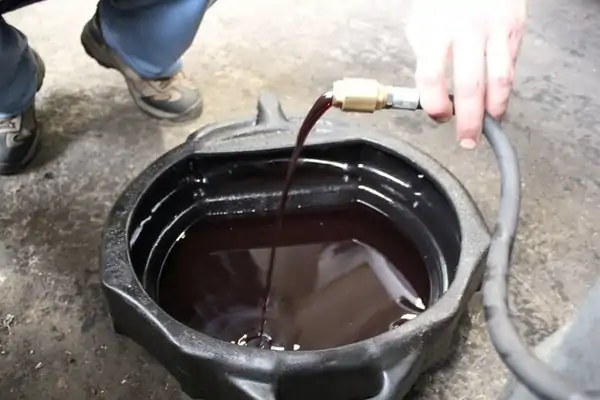
Photo 1. This is what used oil looks like, which is used for heating. The liquid is dark brown in color.
Features of use
The waste is used as fuel in a special boiler or furnace. Only this guarantees complete combustion of the product without the formation of fumes. Re-equipment of the heating system or installation of a new circuit pays for itself in the first year of use of the product.
Types of fuel. How much heat is produced by burning one liter?
Burning one liter of such fuel produces 10-11 kW of heat per 60 minutes. The pre-treated product has more power. Its combustion produces 25% more heat.
Types of used oils:
- motor oils and lubricants used in various types of transport;
- industrial products.
Advantages and disadvantages

Pros of fuel:
- Economic benefit. Consumers save money on fuel, but businesses benefit the most. The implementation of processing eliminates the costs of storage, transportation and disposal of the product.
- Conservation of energy resources. Refusal to use gas and electricity for heating prevents the depletion of sources.
- Environment protection. Due to the high cost of disposal, business and vehicle owners disposed of oil by dumping it into waterways or into the ground. This had a negative impact on the environment. With the beginning of the use of waste as fuel, such manipulations stopped.
Disadvantages of fuel:
- poses a health hazard if the product does not burn completely;
- large dimensions of the chimney - 5 m in length;
- difficulty of ignition;
- the plasma bowl and chimney quickly become clogged;
- The operation of the boiler leads to the combustion of oxygen and evaporation of moisture from the air.
How is oil processed?
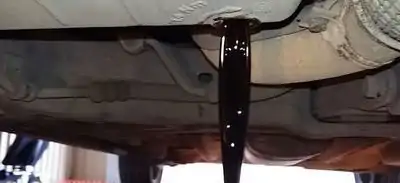
Processing is obtained by burning any type of oil, but for heating the premises, oil refining products from internal combustion engines are usually used.
Also from industrial mechanisms, compressors and power equipment.
What does not apply to such fuel?
List of products not related to waste:
- processed oils of vegetable and animal origin, which are used for household needs;
- solid waste with processing;
- solvents;
- products that are not subject to the same processing as waste;
- natural petroleum fuel from the spill;
- other unused petroleum products.
Exhaust boiler: principle of operation
The calorific value of used engine oil is higher than that of pure diesel fuel
This nuance must be taken into account if you are making a heating boiler for testing yourself.
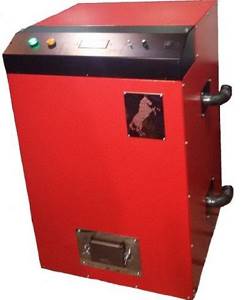
The principle of operation of the boiler is quite simple. The oil pump sends used oil through a hose directly into the evaporation chamber. This boiler element is made of durable metal that can withstand high temperatures. At the same time, the oil evaporates at the very bottom. Oil vapors mix with the air inside and heat the water jacket. This mixture enters the combustion chamber, where it completely burns and heats the coolant. The combustion products themselves enter the chimney and are discharged outside.
Operating rules:
- Do not leave operating devices unattended for a long time;
- In addition to oil, do not burn other materials in the boiler - this may damage the unit;
- Make sure that water does not get inside the boiler, especially on its hot areas;
- Do not turn off the burner;
- During operation, it is prohibited to add oil to the boiler.
Experts warn that constant operation of the boiler at full power can lead to malfunction of the unit or its rapid breakdown.
Do it yourself
To independently assemble a heating boiler that will use used engine oil as fuel, you will have to use the following structural elements:
- Boiler;
- Pump;
- Expansion tank;
- Burner;
- Compressor;
- Special circulation pump;
- Line for the coolant inlet and outlet from the boiler;
- Various equipment designed for welding work.
When assembling the structure, it is taken into account that it will be necessary to make a chimney through which all combustion products will escape outside the building. The ceiling will have to be previously protected from strong heat, so the chimney is placed in a special casing.
Be sure to take into account that the structure must be assembled in such a way that a fairly strong draft is generated in it. It will be necessary to make a damper that will allow you to shut off the draft at once. If it is not possible or desirable to buy a special damper for such a boiler, then they will think over a system to protect the entry of air from outside, because in this case it will be uncontrolled.
In addition, the use of a damper prevents the room from cooling down too much if the equipment is idle for a certain time, so it is still advisable to install such an element.
The homemade design is equipped with an open burner, resulting in the combustion of oxygen in the room. Its deficiency can cause carbon monoxide poisoning, so it is necessary to consider how the room will be ventilated.
It is strictly prohibited to install flammable materials of any kind near the boiler. It is prohibited to touch a working boiler, as it becomes quite hot.
The easiest way is to install a heating boiler assembled by yourself on a stone or on a heat-resistant tile. It is prohibited to cover it with panels made of plastic or wood, as this may cause a fire. You can paint it with heat-resistant materials. If all the features of the technology are observed, the result will be a reliable device that will operate stably without posing a threat to the life, health and property of people.
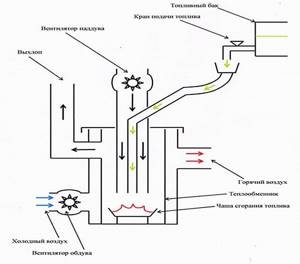
Waste oil boiler diagram
Where to apply and how to modify?
Due to a significant list of disadvantages, waste oil heaters are rarely used in housing. Their use is possible only in utility rooms and in the case of trouble-free supply and exhaust ventilation. But they are widely used for heating technical and production areas.
Motorists use them as heaters for garages, and only if they have a good exhaust hood. Gardeners install them in greenhouses, livestock farmers install them in outbuildings. There is always a place for them at car washes, service stations, and warehouses where there are no flammable materials.
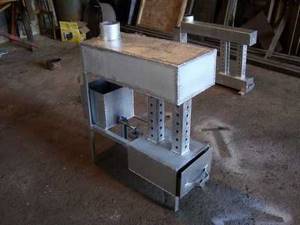
If the operation of a boiler during testing for heating residential premises raises concerns, then in the conditions of a garage, service station and car washes this model is always in demand
Often basic designs are subject to various kinds of modifications. For example, a water jacket or water heating coils are used for these purposes. Such equipment is included in water heating. Furnaces of this type must operate using automation, otherwise their functioning will have to be closely monitored.
Disadvantages of boilers during development
The main disadvantage of such a device is that its reaction to cutting off the air supply to the firebox will not be immediate. Consequently, the combustion process will not stop immediately, but after a certain period of time, during which heating of the coolant will continue. When the flame finally goes out, it will need to be rekindled. This is done manually, unless the design provides for any other approach.
Another drawback of the boiler during testing is its contamination compared to other heating devices. This is primarily due to the fuel used. If the structure is assembled correctly, then it will not emit an unpleasant odor. If the technology is violated, a similar smell will penetrate to one degree or another into the room.
Another, no less significant, disadvantage of such boilers compared to other designs is the need to purify the fuel from various solid impurities, which may include pieces of metal or metal shavings. If you do not adjust the filtration system, the device will fail after a certain time, and returning it to working condition will be very problematic.
https://youtube.com/watch?v=to6LA5z1hCs
Providing drip fuel supply
This issue is one of the most difficult when assembling a heating boiler operating on waste oil. The fact is that solid impurities contained in the oil do not affect the operation of the burner in any way, but the drip mechanism may fail due to them.
In order to get rid of this problem, you can put an oil filter from an old car at the end of the intake hose. With its help, it is possible to achieve complete filtration of the oil. However, it should be remembered that when installing such a part, the filter element will have to be changed on average once a month.
Kinds
Exhaust boilers can heat air directly. Such systems have impressive performance and can warm the air for a long time even in large houses. The peculiarity is that the container with fuel is most often placed on the floor, and the heating block is attached to the wall or even to the ceiling. In addition to this version, there are oil boilers with a water circuit or even a pair of such circuits. A single-circuit device is capable of supplying hot water only to the heating system, if you do not use boilers or distribution equipment.

Industrial models of oil boilers are often equipped with automatic control units.
All such modifications are not air, but water, and the automation is assigned a variety of tasks:
- air temperature monitoring;
- checking the heating of the coolant;
- checking the pressure in the heating circuit;
- alarm about errors that have occurred.
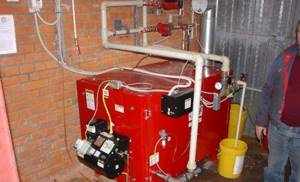
Combined type stove for firewood and mining
A universal metal furnace for working and wood burning has a device in which oil is supplied from above, and firewood is laid from below. In the process of burning solid fuels, the principle of top combustion is used.
The design of the furnace has the following features:
Precautionary measures
The main question of interest to consumers is how safe heating is. Complaints about an unpleasant odor from burning oil indicate non-compliance with the operating rules of the heating device.
It is important to make the right choice of mining. It should not contain substances that can easily ignite, such as gasoline or acetone, and there should also be no third-party additives. They are the ones who contaminate the burner section
When heating, the following safety precautions must be observed:
They are the ones who contaminate the burner section. When heating, the following safety precautions must be observed:
- The cross-section of the pipe must be at least 10 cm. The best option would be to use a sandwich chimney. A small amount of soot forms on its surface.
- Fuel containers should not be stored near the device.
- Containers with oil must be hermetically sealed. If water gets into the fuel, splashing will occur during burner operation, which increases the risk of fire.
- The temperature impact on a boiler with waste oil is much greater than on devices with solid fuel. Therefore, it is necessary to observe the thickness of the walls of the heat exchanger and combustion chamber (2 mm).
To avoid smoke and gas contamination in the boiler room, it is necessary to have a forced air circulation system. It is recommended to maintain air exchange with the following parameters: 180 cubic meters per hour per 1 sq. m. Only if these requirements for heating a country house are met, safe operation of the heating system is possible.
Self-made heating is quite economical and worthy of competing with other types of heating. Its specificity lies precisely in the used oil. This system is good if there are no other options or there is a sufficient supply of fuel. The main area of application for such structures is industrial enterprises where there is a large amount of waste oil.
What should the chimney be like?
The main requirement is serviceability. The system for removing thermal gases that are formed as a result of combustion must be as reliable as possible, and preferably not whimsical.
Main characteristics of the chimney:
- Low thermal conductivity of the materials from which it is made.
- The protrusion from the roof is at least 0.5 meters.
- Arrangement of thermal insulation in places of contact with wooden floors.
- The volume of the chimney must correspond to the amount of gases emitted by one or another heating device.

Don't neglect safety for the sake of the beauty and design of your home or any other building.
Types of units
If you need to organize heating in your home, it is better to purchase a boiler in a standard version. Such designs currently have sufficient autonomy and safety. Comfort and ease of use is also due to the fact that there are no specific odors emitted by fuel.
The boiler operates in automatic mode. This makes it possible to use it without special knowledge and experience. The process of burning oil is designed in such a way that it burns completely without the accompaniment of fumes and the smell of gas.
Heating structures
Such units should not be installed in residential areas. Usually special extensions are used for this. Although the boilers are equipped with modern filters, during operation you can smell the smell of machine oil.
The design of the device has a built-in heating unit, consisting of a water pipe and a pump, which operates not only from the mains voltage, but also from the energy of the device itself. Thanks to it, water circulates evenly in the system.
The operating principle of such devices is based on the combustion of a mixture of fuel and air supplied by a compressor fan. The strength of the fire is regulated using a regular hose, at the end of which a valve is installed.
Water heating devices
The function of these devices is to heat water. They can be called ordinary boilers. They have a platform operating principle: a tank of water is installed on a heated surface. The pump built into the outlet serves to adjust and equalize the pressure inside the system.
This is interesting: the principle of operation of the boiler.
It should be noted that it will be quite difficult to regulate the constant temperature of the liquid. Inside the tank it can reach +80...100°C. Often, such heating systems use coolant containers with a volume of 60–140 liters. The process by which water is heated lasts about 2 hours, which is almost half less than in a boiler.
The hot water boiler has two operating modes. With fast, cold water is heated in the shortest possible time (the automatic switch is in the “wick” mode). In this case, a lot of fuel is consumed, and if the container is small, carbon monoxide emissions are likely.
Appliances
Another subtype of devices of this kind are household boilers. These are multifunctional devices. More often, such designs are used in houses that do not have a water heating circuit. They are equipped with a fairly good gas purification system, which eliminates soot and smoke during operation of the device.
Fuel consumption is very low compared to previous types. Mobility is the main advantage of such a device. It can even be transported in the trunk of a car and used on trips, for example, to nature. In this case, it serves as a cooking stove and also as a heater. The main thing is to provide the fireproof platform or recess in the ground of 30-40 cm required for installation.

